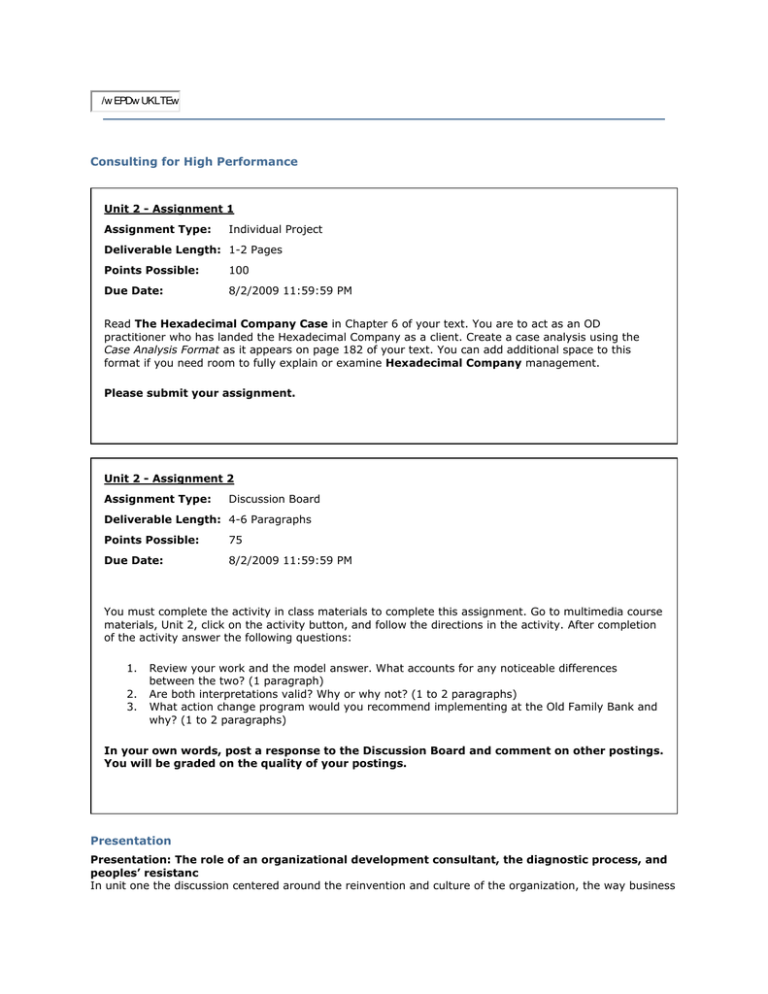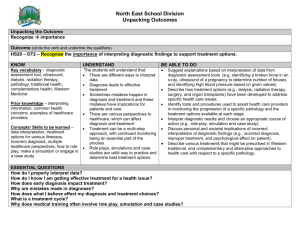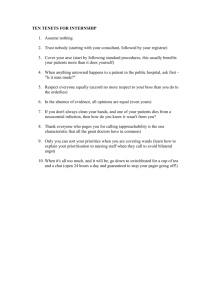MGT420 Unit 2
advertisement

/w EPDw UKLTEw Consulting for High Performance Unit 2 - Assignment 1 Assignment Type: Individual Project Deliverable Length: 1-2 Pages Points Possible: 100 Due Date: 8/2/2009 11:59:59 PM Read The Hexadecimal Company Case in Chapter 6 of your text. You are to act as an OD practitioner who has landed the Hexadecimal Company as a client. Create a case analysis using the Case Analysis Format as it appears on page 182 of your text. You can add additional space to this format if you need room to fully explain or examine Hexadecimal Company management. Please submit your assignment. Unit 2 - Assignment 2 Assignment Type: Discussion Board Deliverable Length: 4-6 Paragraphs Points Possible: 75 Due Date: 8/2/2009 11:59:59 PM You must complete the activity in class materials to complete this assignment. Go to multimedia course materials, Unit 2, click on the activity button, and follow the directions in the activity. After completion of the activity answer the following questions: 1. 2. 3. Review your work and the model answer. What accounts for any noticeable differences between the two? (1 paragraph) Are both interpretations valid? Why or why not? (1 to 2 paragraphs) What action change program would you recommend implementing at the Old Family Bank and why? (1 to 2 paragraphs) In your own words, post a response to the Discussion Board and comment on other postings. You will be graded on the quality of your postings. Presentation Presentation: The role of an organizational development consultant, the diagnostic process, and peoples’ resistanc In unit one the discussion centered around the reinvention and culture of the organization, the way business is conducted. This unit shifts the focus to what people do by examining the role of an organizational development consultant, the diagnostic process, and peoples’ resistance to change. The OD Consultant A change agent is a person or team responsible for beginning and maintaining a change effort. Change agents may come from inside an organization, in which case they are called internal consultants, or they may come from outside an organization, in which case they are called external consultants. The role of the organizational development [OD] consultant is to initiate, stimulate and facilitate change. William Bridges explains that "things" change but people "transition." The OD consultant is therefore concerned primarily with the people aspect of the change events. One of the basic roles of the consultant is to facilitate and teach the client how to identify the problem, diagnose and solve the problem. This reduces the dependency of the client on the consultant but also empowers the client and is associated with higher corporate buy-in rates. Clearly, OD consultants must have a number of skills in order to be successful. In particular, consultants need to possess both leadership and management expertise. In a leadership role, consultants should be able to facilitate rather than direct, keep information flowing, and use multiple methods on a consistent basis. Problem solving is another skill an effective consultant hones. He/she has to be able to identify and focus on the next set of problems. Organizations and processes experience flux which often results in new and unanticipated problems which cannot be ignored. Inherent to the skill of problem-solving, however, is valid diagnosis. So how does an organizational consultant accurately decipher root problems? The Diagnostic Process The diagnosis is a two-fold process: (1) an assessment of the variables, and (2) a report on possible corrective interventions. Diagnosis involves gathering data, interpreting the data, identification of problem areas and options for solutions. Diagnostic tools consist of interviews, surveys, instruments, observation and review of public records. To many, diagnosis is the most important stage. Success or failure of change strategies is dependent on several things but accurate diagnosis is critical. Failure to address the root cause or intervening in processes that were previously fully functional is inappropriate and costly change. But, if the problem is properly diagnosed and the intervention strategy appropriate, why can change still be so difficult for organizations to enact smoothly? Resistance to Change Change is often problematic unless the cause and solution are readily transparent. Generally speaking, change is often resisted. Resistance to change comes from two sources: the individual and the organization. Individual resistance is most often due to habit and security. There is comfort and a sense of security in knowing what is expected by management. Fear of the unknown and group norms are also strong correlates of change resistance. As for the organization, systems are in place for evaluating performance, administering benefits, and numerous other things, and the bureaucracy itself can act to prevent change. People have titles and power and change might threaten those areas of expertise and control or means of resource allocation. Questions and Answers Question #1 Why do some people resist change? It is important to listen to the person resistant to the change. Listen for the fact, belief, feelings or values the person is conveying. Resistance may stem from a single fact, belief, feeling or value. As a consultant it is important to ask non-threatening questions to discern the source of the resistance. Questions to ask about facts are: “What information are you basing that on?” “How do you know that’s true?” “What evidence do you have?” “How did you reach that conclusion?” To understand the beliefs that influence a person’s resistance ask: ‘What’s your opinion of this change?” “What problems do you see with this change?” “Why else should we not make this change?” To understand feelings ask: “How does that make you feel?” “What are your concerns about this?” To understand values ask: “What is important to you about how this is handled?” “What outcomes do you want to see from this change?” “What is the bottom line for you?” Generally speaking overcoming resistance is a four step process: verify the facts; challenge erroneous beliefs; acknowledge feelings; and relate the change to people’s values. Source: Huffman, K. (October, 1995). "Scaling the Wall of Resistance”, Training and Development 49(10)15. Question #2 What are the pros and cons of external and internal consultants and why is the team approach a viable alternative? External consultants may be more objective, but they also have less understanding of the organization. Internal consultants may, on the other hand, be afraid of losing their jobs and are too close to the situation, but they are more aware of problems and familiar with the organization (structure, power networks, nature of business, and so forth). The team approach allows for the benefits of each and may help eliminate the negatives. Additionally, the approach permits sharing of different points of view and may alleviate the possibility of groupthink or dysfunctional decision making processes. Question #3 What are diagnostic models and why are they important? Diagnostic models are systems that help an organizational development practitioner assess an organization. As such, models play a critical role in an organizational development program. Several diagnostic models are currently in use, but some of the more common are the systems model, the analytical model, the emergentgroup behavior model, the management consulting model, the sociotechnical systems model, cause maps and social network analysis model, and the force-field analysis model. Let’s look at each of these. Systems Model: The systems model views the organization as a unified system of interrelated units.. This gives managers a way of looking at the organization as a whole and as part of a larger external environment. Additionally, the notion of system interdependency is critical because a change in one part of the organization has consequences in other parts of the organization. All open systems also have boundaries, but these boundaries are permeable. In other words, external changes also impact and can alter the organizational system. Analytical Model: The analytical model, sometimes referred to as the difference integration model, stresses the importance of a sound analytical diagnosis as the basis for planned change in organizations. The model was developed to study and understand interdepartmental issues by conducting a careful diagnosis of the organization’s problem areas. Emergent-Group Behavior Model: The emergent-group behavior model is based primarily on the work of George Homans and provides a conceptual scheme for analyzing behavior in work groups, particularly the interdependence of groups. Group behavior, from this perspective, emerges as social activity which may or may not assist the group in the performance of their duties. Management Consulting Model: Terry Armstrong and Walter Wheatley developed a diagnostic model for use in management consulting that analyzes six basic factors; planning, general business practices, finance, advertising and promotion, market research, and personnel. Armstrong and Wheatley suggest that it is possible to obtain a few basic responses in each area to gain an indication of where the client’s problems may be located. Sociotechnical Systems Model: The sociotechnical systems model, developed from the work of Eric Trist and others at the Tavistock Institute, is used to analyze the organization as a sociotechnical system interacting with its external environment. From this perspective there are two systems — the social system and the technological system — which are interrelated and interdependent, The diagnosis determines how these systems interrelate and specifically, the type of feedback or lack of feedback between the various subsystems that may be the source of organizational problems. Cause Maps and Social Network Analysis Model: Reed E. Nelson and K. Michael Mathews have suggested the use of cause maps and social network analysis in diagnosis. Cause maps are mathematical representations of perceived causal relationships among variables. By analyzing the causal makeup of the organization and information about specific interdepartmental relationships, knowledge is gained of important interdependencies. Force-field analysis model: The force-field analysis model, originated by Kurt Lewin, is a diagnostic technique that views organization behavior as a balance of forces that push for and restrain change. Restraining forces act on the organization to keep it stable and driving forces put pressure on the organization to change. If the forces for change and the forces against change are equal, the result is organizational equilibrium. Change takes place when the organization is experiencing imbalance which can be planned and specifically brought into being by decreasing the strength of any one of the forces, introducing a new force, decreasing the strength of any one of the forces, or by a combination of these methods. Question #4 What are major forces in the change process? Forces can be either driving or restraining. Driving forces are anything that increases the inclination of the client system to implement the proposed change program. Alternatively, restraining forces hinder the development of the change program. Question #5 What strategies might be used in gaining acceptance for an organizational development program? Initially, two things in reducing resistance should be recognized. First, resistance to change can be predicted, and second, resistance cannot be repressed effectively in the long run. In short, resistance to change of some type is inevitable. The task of the manager or the organizational development practitioner is to make conflict resulting from the resistance a creative force for the organization’s greater good and a strategy for gradually gaining acceptance of change initiatives. These strategies may include; a systematic plan, inclusion of members, education and communication of proposed changes, managers creating a vision of the organization, recognition of resistance to change, providing support and a reward system for those involved, leadership of key managers, negotiation, explicit and implicit coercion, and the use of power. Resource Links Are You a Change Leader? (http://www.corpchange.com/archives/article_archives/a19_are_you_a_change_leader/a19_are_you_a_cha nge_leader.htm) This article examines the levels of change leadership competency on a behavioral scale starting with the most basic level of skill and moving to the most complex level. Change Management 101: A Primer (http://home.att.net/~nickols/change.htm) The purpose of this paper is to provide a broad overview of the concept of “change management.” Change Management Wisdom (http://humanresources.about.com/library/weekly/aa030701a.htm) This is a brief summary of lessons learned. Culture Change: Summary of Key Thinkers’ Ideas (http://www.change-management.net/index.html) This is a set of notes about culture change, summarizing the key ideas of the authors cited. Enduring Skills of Change Leaders (http://www.pfdf.org/leaderbooks/l2l/summer99/kanter.html) This article examines the necessary skills of effective change leaders. Leading Transition: A New Model for Change (http://www.pfdf.org/leaderbooks/l2l/spring2000/bridges.html) This article examines the necessity of coaching leaders in the change process. Model for Change Management (http://www.change-management.com/tutorial-adkar-overview.htm) This tutorial presents an overview of the ADKAR model for change management. This diagnostic tool helps employees understand where they are in the change process. Tips and Checklists (http://www.itstime.com/aug96.htm) Tips on what to do in the five steps of a change process. Tips for Change Agents (http://www.fastcompany.com/online/05/changetips.html) Here are nine lessons for change agents.



